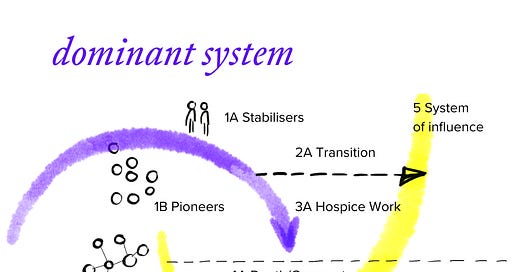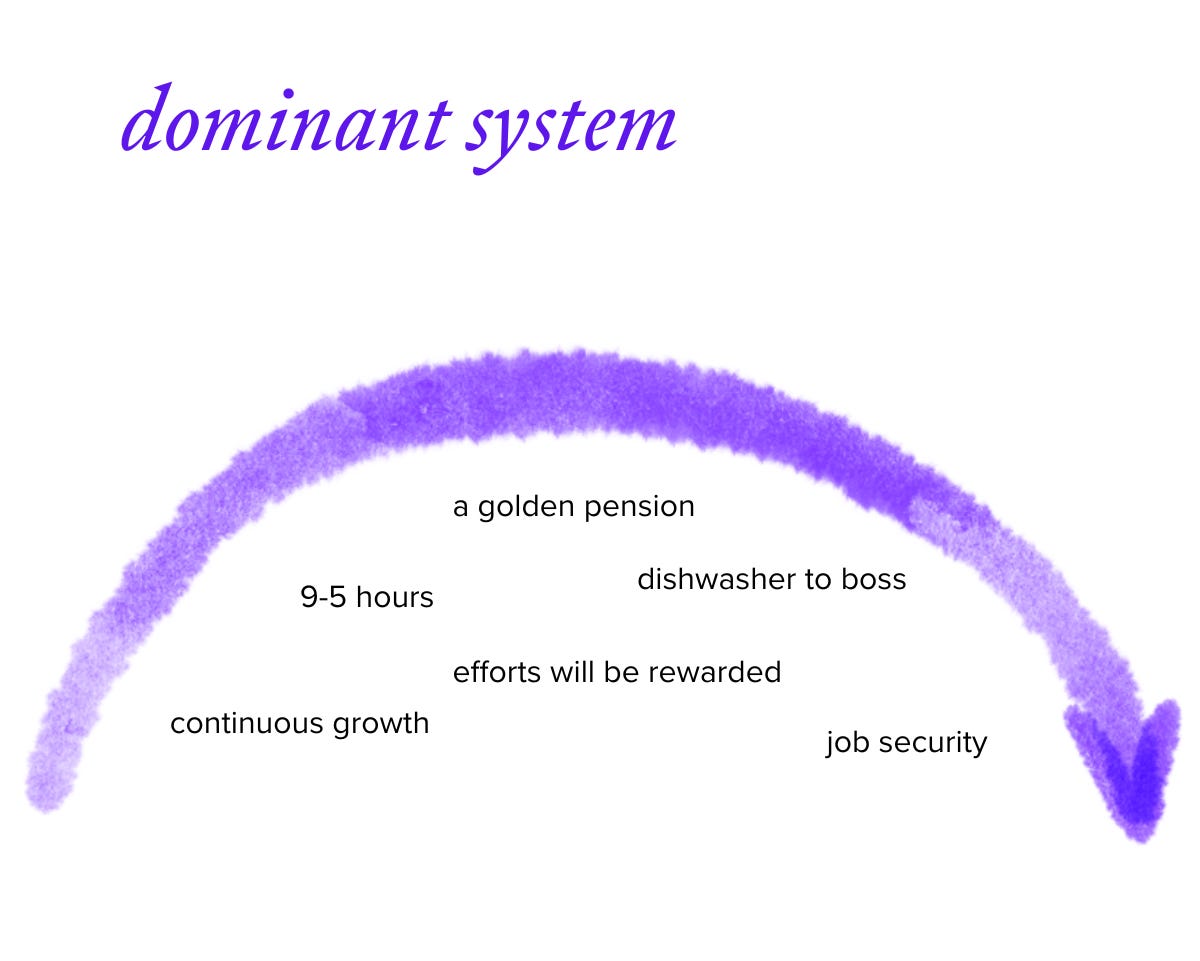Two loops to help you understand your role as a change-maker
– and to help you build empathy for those who are resisting transformation.
Recently, I was sitting at an airport near a waiting line and witnessed a father—in his fifties—loudly complaining to his teenagers about how many people were flying. "These are those Digital Natives," he said. "They all don't want to work anymore; they just want more free time, you know. And 'purpose'!"—he laughed loudly. And he added, "These are also the ones who block the streets in the city with their bicycles. And yet they still all fly around the world." He called them "inconsistent" and "Hippocrates!" To my surprise, his children listened attentively and nodded.
I looked around and didn't see any Digital Natives—mostly Generation X in grey suits and trolleys and a few Millennials, to which I also belong. And yes, meaning and autonomy are essential to me, too. But I didn't know where to start. Although half of what he said was completely wrong, this gentleman had simultaneously pressed several of my buttons. But what was it that triggered me the most? Was it his lack of understanding of the need for more meaningfulness? Or his incomprehension of resisting the destruction of our planet? But above all, it was the fact that he was passing on this mindset to his children and that only half of his statements were coherent.
Choose Battles Wisely
Instead of confronting him—which I would have liked to do—I took a deep breath and tried looking at this situation more empoweringly. It saddened me so much that he did not understand why the generations after him differed. So, I tried it the other way around. I tried to understand his lack of empathy for the younger generations.
Understanding Change and Resistance: The Two Loops Model
To illustrate this, let's turn to the Two Loops Model from the Berkana Institute1 , a framework I learned at Regenerators Academy2. This model helps me situate myself within a changing system and understand the roles others play, especially when I feel "triggered" or out of place.
The model outlines how social, economic, or organizational systems evolve. A dominant system starts to decline as a new, emergent system forms. This model shows how different roles are played in each phase, whether within the old or new system. It's a tool that can be used for personal reflection or in any transformational work involving change.
I will apply this model to the current world of work in industrialized, democratic societies, where a traditional system is crumbling and a new one is still being forged. This reflection isn't about blame—it's about understanding the tension and finding solutions through dialogue.
The Dominant System: The Traditional Work Model
In my example, the dominant system is the traditional 9-to-5 work model, with rigid hierarchies and profit-driven priorities. Historically, climbing the career ladder meant stability, self-fulfilment, and social status. For Baby Boomers, work was a duty and a source of identity, and it promised stable growth and job security, often extending well into retirement.
Highly hierarchical organizational systems peaked with increasing industrialization and the growth of large companies in the 20th century, leading to stable organizational structures and a solid work culture. The promise was: "From dishwasher to boss." If you worked hard, your work would be rewarded.
Generation X, which includes the gentleman I encountered, grew up valuing work for the financial stability it provided. This generation faced economic changes, job insecurity, and crises that shaped a pragmatic approach to work. For them, success meant self-responsibility and securing a solid financial future.
Decline of the Dominant System – The Broken Promise
Now, as Baby Boomers retire, Generation X realizes that the security they were promised may not be guaranteed. Job security is no longer a given, especially for those nearing the end of their careers. The suspicion grows that the promise of the golden pension is broken—if not for them, for sure for the following generations. Now imagine how it sounds to these people when the younger generation starts talking about "purpose" and flexibility at work. It sounds like treason. GenX would have to admit that the system they contributed for a lifetime doesn't work, stabilizing what they know and hoping for the best.
For Millennials and Gen Z, the cracks in this system are clearer. The system is losing its effectiveness. Many of us feel that the traditional work model doesn't offer the stability it once did. And running in the hamster wheel no longer guarantees a great pension or owning a home. Instead, it often leads to burnout, financial strain, and dissatisfaction. We are increasingly asking: why continue supporting a system that doesn't work for us or the planet? No wonder we ask, "Why?"
“It’s more important to be good ancestors than dutiful descendants. Too many people spend their lives being custodians of the past instead of stewards of the future. We worry about making our parents proud when we should be focused on making our children proud. The responsibility of each generation is not to please our predecessors—it’s to improve conditions for our successors.”
― Adam M. Grant
The Emergent System: The New Way of Working – a New Hope?
At the same time, new approaches to work are emerging. Flexible work models, hybrid offices, and a focus on work-life balance are becoming more common, accelerated by the COVID-19 pandemic. The emphasis shifts from physical presence to results, from climbing corporate ladders to finding meaningful work that aligns with personal and societal values.
Yet, these new ideas are fragile and still in flux. We're exploring solutions through trial and error, hoping to find a model that supports personal fulfilment and collective well-being.
The Immune Defense of the System: The Role of Stabilisers
In any large and established system, whether a company, an industry, or society, forces are designed to maintain stability and resist disruption. These forces can be thought of as the system's immune defence. Much like the human body reacts to anything foreign or threatening, the dominant system has built-in mechanisms that protect it from change, often viewing innovation or new ideas as "threats" to its equilibrium.
These Stabilizers play a critical role in slowing down transformation and ensuring that the system remains as it is for as long as possible. While these forces are essential to providing continuity and structure, they can also hinder progress and adaptation, making it difficult for pioneers or change-makers to introduce new ways of working or thinking.
Understanding Roles in Transition
Within the Two Loops Model, individuals take on various roles during transitions between the old and new systems. Some are Pioneers, those early adopters who recognize the limitations of the old system and start creating alternatives. Others are Connectors who help build networks between different innovators and practices. There are also Communities of Practitioners, groups that test and refine new ways of working, helping to strengthen the emergent system. Finally, we have Hospice Workers, who tend to the decline of the old system, and Bridge Builders, who help transition people from the old system to the new.
In my own experience, I've worn many of these hats. I've worked to bring new, more agile working methods into traditional companies and helped to build communities around shared values.
Empathy in Action: Nourishing the Transition
The encounter at the airport reminded me of the tensions between the old and new systems and how resistance often comes from fear. The father's frustration might not have been just about the younger generation's values but a more profound struggle to reconcile the broken promises of a system that had once seemed reliable. His children's attentive nods showed me how easily such mindsets could be passed down.
As change-makers, whether we are Pioneers, Connectors, Hospice Workers, or Bridge Builders, we have a responsibility not just to push for new systems but also to show empathy to those feeling left behind. Transformation is not just about driving forward; it's about building bridges, easing fears, and ensuring that change is something shared—not imposed.
We must remember that change, while inevitable, is also emotional. It's not just about systems and structures but people—like the father at the airport—struggling to make sense of a world in flux. By understanding their fears and offering support, we can transform a journey of collective growth rather than division.
Resources
📝Article: Using Emergence to Take Social Innovation to Scale. Berkana Institute
📚Book: Grant, A. (2023). Hidden Potential. Penguin.
Wheatley, M. and Frieze, D. (n.d.). Using Emergence to Take Social Innovation to Scale. Berkana Institute. [online] Available at: https://berkana.org/wp-content/uploads/2020/04/Emergence-Booklet-English.pdf.









As a connector working on the emergence of a more sustainable energy system this was a great read! I’ve read a lot about transition models but never heard of this one before. Thank you for sharing, very interesting!